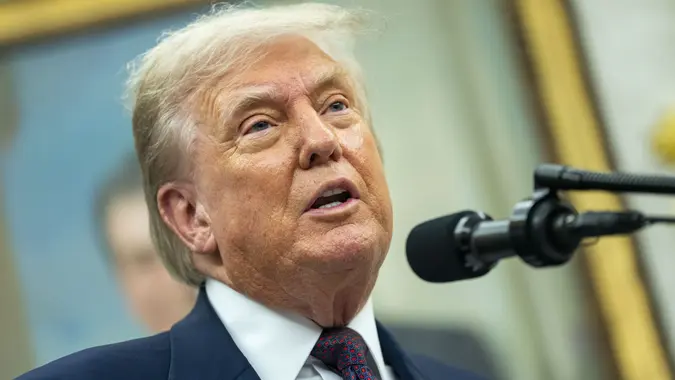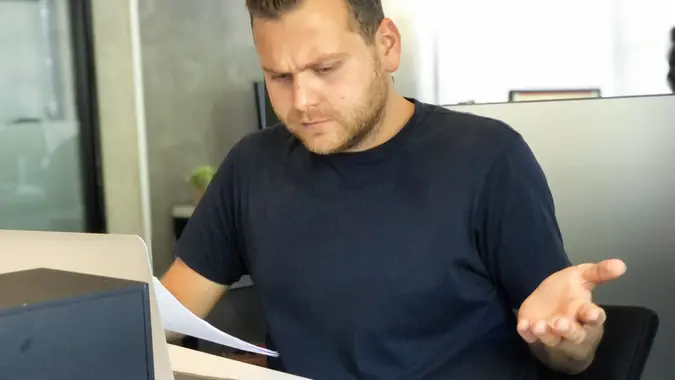I Inherited $500,000: Here’s What I Did With It To Secure My Financial Future

Commitment to Our Readers
GOBankingRates' editorial team is committed to bringing you unbiased reviews and information. We use data-driven methodologies to evaluate financial products and services - our reviews and ratings are not influenced by advertisers. You can read more about our editorial guidelines and our products and services review methodology.

20 Years
Helping You Live Richer

Reviewed
by Experts

Trusted by
Millions of Readers
Receiving a sudden windfall, like inheriting a substantial amount of money, can be surprising and exciting. It can also incredibly overwhelming. Perhaps most importantly, it brings a significant responsibility: ensuring you manage this newfound wealth wisely to secure your financial future.
According to financial advisor David S. Kates, it’s crucial not to let emotion drive your decisions. “First and foremost, work with an advisory team who will take the time to thoroughly explore and review your new financial circumstances,” he advised.
When Cameron Heinz inherited $500,000, he viewed it as an opportunity to pursue his passion for innovation while making a positive difference in people’s lives. Instead of splurging or making risky investments with the windfall, he carefully researched the market, developed products, built a team and launched a business called Mobility Nest.
Here are the steps Heinz took to make the most of his inheritance in pursuit of building a company.
Follow Your Passion
Heinz knew that the money he inherited gave him a unique opportunity to transform his passion into a reality. He had a chance to do what he loved and to help people at the same time.
As he said, “When deciding how to use an inheritance, pursue something you are passionate about. It will keep you motivated even during challenging times.”
By building on what genuinely motivates you, an inheritance can do more than secure your finances — it can help you achieve personal fulfillment.
Conduct Market Research
Heinz wanted to find a good business idea. He started by looking for places where there was a business opportunity that he could fill. He needed to figure out what people needed but couldn’t find in the market.
As he put it, “I started by conducting extensive market research to identify gaps and opportunities in the mobility sector. This research helped me understand the needs and preferences of potential customers.”
Once he knew what people wanted, Heinz used some of the money he inherited to make it easier for people to get around.
Build Out Products and a Company
Recognizing the importance of having the right team in place, Cameron stated, “I assembled a talented team of individuals who shared my vision. Having the right team in place is crucial for any startup’s success.”
He then led the effort to rigorously prototype and test their mobility products to ensure they met the highest standards before launch. Once he identified opportunities to create better mobility options, he used some of his inheritance to make new and improved products that would help people get around more easily.
As Heinz described, “Armed with valuable insights, I invested a portion of the inheritance into developing innovative mobility solutions. I aimed to create products that would enhance accessibility and convenience for people with diverse mobility needs.” He knew that prototyping and rigorous testing would be critical, noting “We created prototypes of our mobility solutions and rigorously tested them. This phase allowed us to refine our products and ensure they met the highest standards of safety and usability.”
Launch and Marketing
With high-quality offerings in hand, Mobility Nest officially launched with a strong marketing campaign that emphasized the company’s commitment to improving mobility for all. Cameron also made customer feedback a priority, using input to continuously refine and enhance their products and services. As he advised, “Be open to feedback. Listen to your customers and be willing to adapt and improve based on their feedback.”
By using his inheritance wisely to make his ideas real, Heinz made sure he had enough money for the future. It wasn’t easy, but it paid off with a successful business that helped people.
What To Do With Your Inheritance
If you find yourself with a large inheritance on your hands, here’s how experts recommend handling it.
Take a Measured Approach
“Don’t rush, make educated decisions,” Kates said. Take time upfront to evaluate your literacy on money management and investments. Define your motivations and goals for the inheritance, whether growth, stability, philanthropy or a blend. Revisit these periodically as your situation changes.
Create a Flexible Plan
Kates stressed the need for an adaptable plan. “Prepare detailed, ongoing cash flow and budgeting analyses.” Model different scenarios around major purchases, market conditions, and retirement savings to stress-test your strategy. This will help build resilience into your financial framework.
Optimize Your Assets
Optimizing your portfolio’s tax efficiency is also crucial. “Review overall asset allocation including recommendations for taxable vs. qualified accounts,” Kates explained. Strategic placement of fixed income, equities, real estate and other assets can minimize tax exposure.
Plan for the Future
Kates said, “Evaluate the use of trusts and other vehicles to help minimize potential estate tax exposure, liability protection and probate avoidance/privacy. Evaluate and, if possible, maximize both lifetime and annual gifting exclusions prior to the impending 2026 reduction.” Be sure to carefully designate beneficiaries for retirement plans and life insurance.”
Mitigate Risk
On risk management, Kates advised to review your “personal liability, property/casualty (e.g. home, auto, watercraft etc.), life, disability and long-term care in light of potential increased needs in some areas and reduced needs in others.” Reviewing insurance regularly prevents gaps or redundancies.
Give Back With Purpose
For charitable aims, Kates said, “Evaluate charitable planning options including which assets to gift (e.g. cash vs. appreciated securities vs. real property vs. business interests etc.). Explore the use of family foundations, donor advised funds, direct gifts and trust strategies.” This allows for giving back thoughtfully in line with your values.
 Written by
Written by  Edited by
Edited by 

























